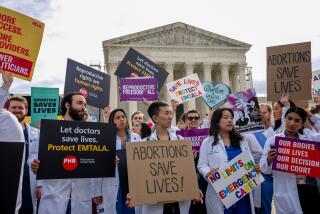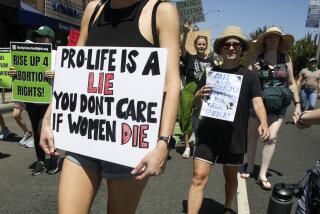Idaho hospitals begin rationing healthcare amid COVID surge

- Share via
BOISE, Idaho — Idaho public health leaders announced Tuesday that they activated “crisis standards of care” allowing healthcare rationing for the state’s northern hospitals because there are more COVID-19 patients than the institutions can handle.
The Idaho Department of Health and Welfare quietly enacted the move Monday and publicly announced it in a statement Tuesday morning, warning residents that they may not get the care they would normally expect if they need to be hospitalized.
The move came as the state’s confirmed coronavirus cases skyrocketed in recent weeks. Idaho has one of the lowest vaccination rates in the U.S.
The state health agency cited “a severe shortage of staffing and available beds in the northern area of the state caused by a massive increase in patients with COVID-19 who require hospitalization.”
The designation includes 10 hospitals and healthcare systems in the Idaho panhandle and in north-central Idaho. The agency said its goal is to extend care to as many patients as possible and to save as many lives as possible.
The move allows hospitals to allot scarce resources such as intensive care unit rooms to patients most likely to survive.
Other patients will still receive care, but they may be placed in hospital classrooms or conference rooms rather than traditional hospital rooms or go without some lifesaving medical equipment.
Other states are preparing to take similar measures if needed. Hawaii Gov. David Ige quietly signed an order last week releasing hospitals and healthcare workers from liability if they have to ration healthcare.
Idaho Department of Health and Welfare Director Dave Jeppesen made the decision to enact the crisis standards about 5 p.m. Monday after the state’s Crisis Standards of Care Activation Advisory Committee determined that all other measures taken to help relieve staffing and bed shortages had been exhausted.
The department waited until Tuesday morning to make the public announcement “out of respect to the hospitals,” department spokeswoman Niki Forbing-Orr said in an email. She did not elaborate or immediately respond to questions seeking more details.
The unfolding crush of patients to Idaho hospitals has been anticipated with dread by the state’s heathcare providers. Medical experts have said that Idaho could have as many as 30,000 new coronavirus cases a week by mid-September if the current rate of infections lasts.
“Crisis standards of care is a last resort. It means we have exhausted our resources to the point that our healthcare systems are unable to provide the treatment and care we expect,” Jeppesen said in a statement.
He added: “This is a decision I was fervently hoping to avoid. The best tools we have to turn this around is for more people to get vaccinated and to wear masks indoors and in outdoor crowded public places. Please choose to get vaccinated as soon as possible — it is your very best protection against being hospitalized from COVID-19.”
The designation will remain in effect until there are enough resources — including staffing, hospital beds and equipment or a drop in the number of patients — to provide normal levels of treatment to all.
More than 500 people were hospitalized statewide with COVID-19 on Sept. 1 — the most recent data available on the Department of Health and Welfare’s website — and more than a third of them were in intensive care unit beds.
Idaho’s hospitals have struggled to fill nursing, housekeeping and other healthcare positions, in part because some staffers have left because they are burned out by the strain of the pandemic and because others have been quarantined because they were exposed to COVID-19.
Late last month, Gov. Brad Little called in 220 medical workers available through federal programs and mobilized 150 Idaho National Guard troops to help hospitals cope with the surge.
Two hundred of the federal workers are medical and administrative staffers available through a contract with the U.S. General Services Administration. The U.S. Department of Defense agreed to send a 20-person medical response team to northern Idaho. The Idaho National Guard troops will help with logistical support such as screenings and lab work.
On Tuesday, the governor called the move to limit care “an unprecedented and unwanted point in the history of our state” and urged residents to get vaccinated against COVID-19.
Data from the U.S. Centers for Disease Control and Prevention show that full vaccination with any of the currently available vaccines dramatically reduces the risk of requiring hospitalization for a coronavirus infection.
“More Idahoans need to choose to receive the vaccine so we can minimize the spread of the disease and reduce the number of COVID-19 hospitalizations, many of which involve younger Idahoans and are preventable with safe and effective vaccines,” said Little, who is a Republican.
When the pandemic first came to Idaho at the start of 2020, Little ordered a partial shutdown of the state — ordering some businesses to temporarily close or shift to takeout services, banning some large gatherings and asking residents to stay home as much as possible.
The move was aimed at ensuring that hospitals wouldn’t become overwhelmed. Idaho was on the verge of enacting crisis standards of care during a major coronavirus surge last winter, but narrowly avoided doing so — making this the first time the state has taken the drastic measure.
Little reopened the state in stages over several months and has not reimposed restrictions limiting gatherings. Businesses are mostly operating as normal.
The state’s crisis guidelines are complex and give hospitals a legal and ethical template to use while rationing care.
Under the guidelines, patients are given priority scores based on a number of factors that affect their likelihood of surviving a health crisis.
Those deemed in most in need of care and most likely to benefit from it are put on priority lists for scarce resources such as ICU beds.
Others in dire need but with lower chances of surviving will be given “comfort care” to help keep them pain-free whether they succumb to their illnesses or recover.
Other patients with serious but not life-threatening medical problems will face delays in receiving care until resources are available.
More to Read
Sign up for Essential California
The most important California stories and recommendations in your inbox every morning.
You may occasionally receive promotional content from the Los Angeles Times.









